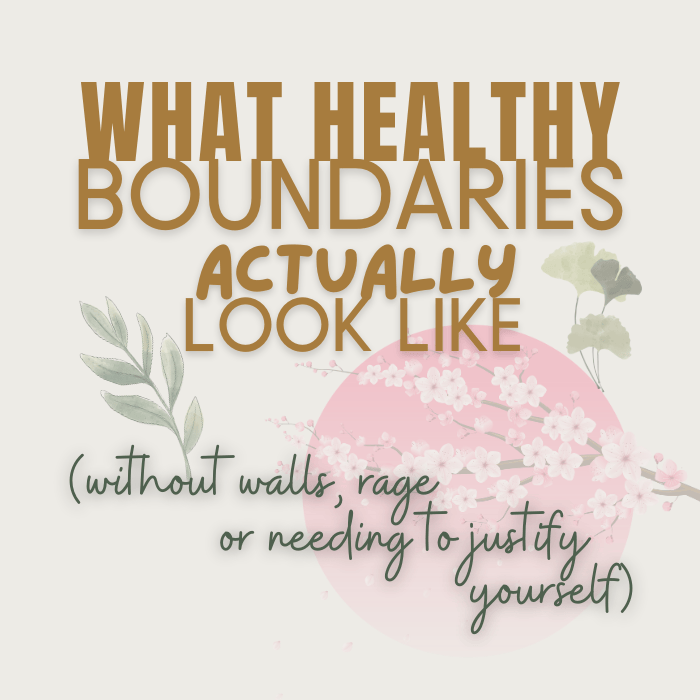(Without Walls, Rage, or Needing to Justify Yourself 🪷)
Boundaries often get misunderstood.
They’re not about building walls, pushing people away, or proving your worth.
They’re about honoring your truth — gently, clearly, and consistently.
For many who’ve spent a lifetime people pleasing, the idea of setting boundaries can feel foreign. Or even scary.
You might wonder:
- “Am I being selfish?”
- “Will they still like me?”
- “What if they don’t understand?”
So let’s slow it all down.
Let’s explore what healthy boundaries actually look and feel like — especially when you’re learning to set them from a place of self-connection, not self-protection.
Some links on this page are affiliate links. If you choose to purchase through them, it supports this site at no extra cost to you. Thank you for your support. 🤍
1. Healthy Boundaries Are Grounded, Not Harsh
They don’t need to come with a dramatic announcement.
They don’t need to be forceful.
In fact, the most effective boundaries often sound simple:
- “I’m not available for that.”
- “I’ll pass this time.”
- “That doesn’t work for me.”
- “I need to leave by 6.”
No long explanation.
No apology.
Just clarity + care.
If you’re still wondering what kinds of boundaries are considered healthy — or how they might apply to different areas of life — this gentle guide from Psych Central offers grounded, compassionate insight: What Healthy Boundaries Look Like. It’s a soft companion to help you explore what honoring yourself might begin to look like in real situations.
2. Healthy Boundaries Include You — Not Just Others
Many people pleasing patterns revolve around what others need.
Boundaries ask:
“What do I need?”
This might mean:
- Leaving a social event early, even if others want you to stay
- Saying no to a favor, even if someone is disappointed
- Taking a pause before replying, even if you’re expected to respond fast
These aren’t rejections of others — they’re inclusions of you.
🤍 If this feels new, you might find grounding in First Gentle Steps Beyond People Pleasing — especially the part about saying one honest truth per day.
3. Healthy Boundaries Honor Your Nervous System
Your body often knows when something is too much — before your mind does.
Listen for cues like:
- Tight throat or chest
- Shallow breath
- Feeling “off” but unsure why
- A heavy or shrinking sensation in your gut
Boundaries don’t always need justification.
“I feel off” is reason enough.
The guide on What Safety Feels Like in the Body can help you begin discerning what’s truly okay for your system — and what’s not.
4. Healthy Boundaries Don’t Always Sound Like “No”
Sometimes, a boundary is an agreement — a way to protect your energy proactively.
For example:
- “I’m happy to talk, but I only have 15 minutes.”
- “I can help with that, but I’ll need a few days.”
- “I’d love to hang out — can we make it a quiet one?”
You’re not shutting someone out.
You’re shaping the container that feels right for you.
5. Healthy Boundaries Can Be Soft and Kind
You don’t need to be sharp or cold to be clear.
You can say:
- “I care about you, and this doesn’t feel right for me.”
- “I’m learning to take better care of my energy.”
- “I love that you asked — I’m a no this time.”
Kind doesn’t mean vague.
Softness and strength can live together.
6. Healthy Boundaries Get Easier With Practice
At first, they may feel clunky.
You might over-explain, apologize, or backtrack. That’s okay.
Boundaries are not a performance — they’re a practice.
And the more you keep returning to yourself, the clearer they’ll become.
🌿 FAQ: Boundaries for Sensitive Souls
Q: Is it still a boundary if I feel bad after?
A: Yes. Guilt, fear, and doubt often surface when you start honoring yourself. These feelings are old conditioning, not proof you’ve done something wrong.
Q: Do I need to explain my boundary to others?
A: You can — but you don’t have to. Your needs are valid even if they’re misunderstood.
Q: What if someone keeps pushing past my boundaries?
A: That’s information. A healthy boundary invites respect — and if that’s not possible, further distance or change may be needed. Your peace is not selfish.
Gentle Next Step
You don’t have to set perfect boundaries.
You don’t have to get them right every time.
You’re allowed to practice.
~You’re allowed to be clear and kind.
You’re allowed to include yourself, even if it feels new.
Each time you listen to your body, each time you honor your own edge — even quietly — you are building a new foundation of safety inside.
If you’d like gentle support in continuing this path, you might explore:
→ Moving Beyond People Pleasing: First Gentle Steps
You are allowed to take up space 🤍
And you are already beginning.
If you’d like a guided space to practice this work at your own pace, The Better Boundaries Workbook by Sharon Martin is a thoughtful, practical companion. It’s designed with gentle clarity — especially helpful if you’re someone who’s learning to set boundaries without guilt or sharpness.
Your unfolding is already underway — and it’s beautiful.

